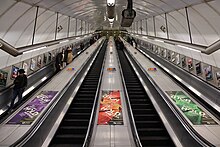Holborn tube station
Before 1994, Holborn was the northern terminus of the short and little-frequented Piccadilly line branch to Aldwych and two platforms originally used for this service are disused.[10] The station entrance and exit sections of the street façade were constructed in granite with the other parts of the ground and first floors in the same style, but using Portland stone.[27] [10] The street level interchange between the GNP&BR and CLR involving two sets of lifts was considered a weakness in the network.[10] The station frontages on Kingsway and High Holborn were partially reconstructed to modernist designs by Charles Holden with the granite elements replaced with plain Portland stone façades perforated with glazed screens.[10] The lifts were removed and a spacious new ticket hall was provided giving access to a bank of four escalators down to an intermediate concourse for the Central line platforms.[26] The station was redecorated in the 1980s, with platform walls lined with panels of enamelled metal forming murals designed by Allan Drummond that reference the British Museum.[32] Sunday services ended in April 1917 and, in August of the same year, the eastern tunnel and the bay platform at Holborn were formally closed.[33] Wartime efficiency measures led to the branch being closed temporarily on 22 September 1940, shortly after the start of The Blitz, and it was partly fitted out by the City of Westminster as an air-raid shelter.Again it survived, but the service was reduced in June 1958 to run only during Monday to Friday peak hours and Saturday morning and early afternoons.[38] In the aftermath of the King's Cross fire in 1987, the Fennell Report into the disaster recommended that London Underground investigate "passenger flow and congestion in stations and take remedial action".[46] On 21 October 1997, a 9-year-old boy, Ajit Singh, was dragged to his death after a toggle on his anorak was trapped in the closing doors of a Piccadilly line train.[47] The disused branch line platform and other parts of the station have been used in the filming of music videos for Howard Jones' "New Song", Leftfield's "Release the Pressure", Suede's "Saturday Night" and Aqua's "Turn Back Time".[52] Patrick Blackett (who won the Nobel Prize for his discovery of the positron), developed plans to install a cosmic ray detector on an abandoned platform of the Holborn Station following a row with his mentor Lord Rutherford at Cambridge University.This was the only part of London with an underground tram system, and Holborn tramway station (named Great Queen Street when first opened) is still extant beneath ground, though with no public access.


HolbornLondon Borough of CamdenLondon UndergroundCoordinatesCentral LondonHigh HolbornKingswayCentralPiccadillyTravelcard Zone 1Tottenham Court RoadChancery LaneCovent GardenRussell SquareBritish MuseumLincoln's Inn FieldsRed Lion SquareBloomsbury SquareLondon School of EconomicsSir John Soane's MuseumGreat Northern, Piccadilly and Brompton RailwayAldwychlocation filmingLondon Transport MuseumGreat Northern and Strand RailwayWood GreenBrompton and Piccadilly Circus RailwayCharles Yerkesholding companyUnderground Electric Railways Company of LondonPiccadilly CircusLondon County Counciltramway subwayLeslie GreenterracottaPortland stonetrapeziumCentral London Railwayprivate billCharles Holdenescalatorstube mapsenamelled metaltrompe-l'œilFinsbury ParkThe BlitzCity of Westminsterair-raid shelterElgin MarblesLondon TransportLondon Regional Transportsecretary of state for transportKing's Cross fireTransport for LondonCrossrailCentral line1962 stockLiverpool StreetWhite CityHainaultEaling Broadwaytrain stopPiccadilly lineHoward Jones'New SongLeftfieldRelease the PressureSuede'sSaturday NightAqua'sTurn Back TimeGeoffrey HouseholdRogue MalePatrick BlackettNobel PrizepositronLord Rutherfordcloud chamberAldwych shuttleLondon fare zone 1London tram networkKingsway Tramway SubwayHolborn tramway stationLondon BusesSuperloopBBC Pronunciation Unitˈhəʊbə(r)nThe London GazetteYouTubeDaily MirrorHoward JonesDepartment of TransportHousehold, GeoffreyPenguin BooksWolmar, ChristianWest RuislipEppingWoodfordNewbury ParkUxbridgeRayners LaneHeathrow AirportTerminal 4Terminal 5CockfostersArnos GroveTheydon BoisDebdenLoughtonBuckhurst HillSouth WoodfordSnaresbrookRoding ValleyChigwellGrange HillFairlopBarkingsideGants HillRedbridgeWansteadLeytonstoneLeytonStratfordMile EndBethnal GreenSt Paul's